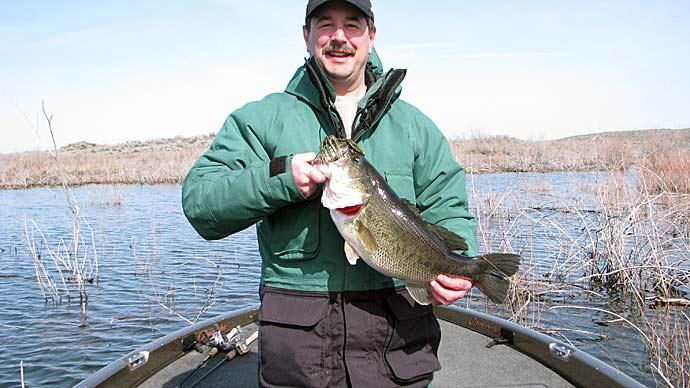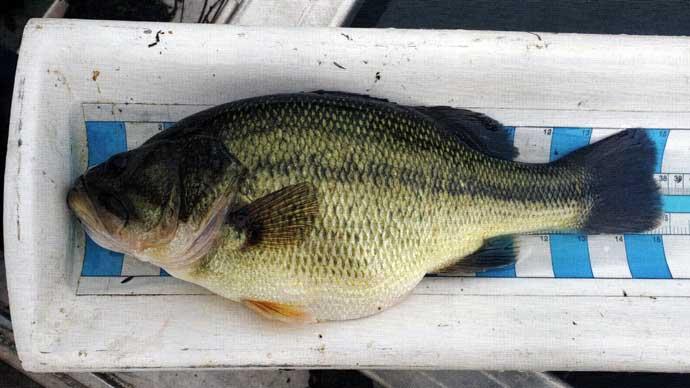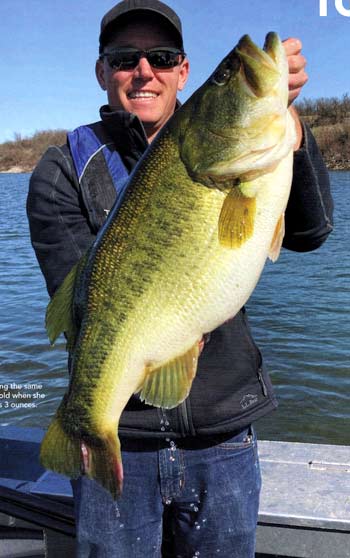
Each spring, we all hear tales about giant Largemouth bass. Sometimes, there are photos, or even better, the fish itself, or newspaper clippings to prove the legendary fish exists, helping the angler share the accomplishment with others. These fish are scarce.
Here's one of those fantastic stories with a different twist.
A legendary fish is being raised and documented on the Nail Ranch outside Albany, Texas. A historic Shackelford County ranching family owns the ranch. Bucky and Jamie Nail are fourth-generation ranchers who actively manage the spread. It was established in the late 1800s and served primarily as a cow-calf operation. Rich with history, it was one of the first properties to offer commercial hunting in Texas in the early 1980s and still does today.
Wildlife thrive here, such as White-tailed deer, feral hogs, turkeys, Bobwhite quail, and ducks. There are no high fences or released game. White-tail are the primary target game species, and the ranch strives to provide a well-rounded experience, hunting in a natural, low-fence setting.
Lakes and ponds are scattered across the 40,000 acres of rolling hills and flat land, with a couple of lakes having a history of producing double-digit bass. Although fishing has not been a primary focus, they plan to use angling as a value-added offering in the future.
This fantastic journey you're about to learn started in 2011 when the area began suffering from a severe drought. That drought lasted until the spring of 2015. Lakes and ponds dried up. Livestock needed water. Cowboys and ranch hands did what they had to do to find water for the operation. The Nails did what most ranchers do during excessive droughts. They reworked dams and reshaped pond bottoms to hold more water.
While stock water was the significant focus, several larger lakes deserved dual attention as fishing lakes. Why not use drought to set the stage for great fishing later?
South Mill Lake is one of the primary fishing lakes tucked away in a gorgeous setting between two hills in a remote area. It is 33 acres when full, averages 6-7 feet deep, and has a maximum depth of 30 feet. Its expansive watershed totals 3,930 acres.
A few years after being reworked, South Mill Lake finally filled with water and was ready for stocking and management. Bucky reached out to SOLitude for help. Fisheries Biologist Paul Dorsett worked with Buck to design a customized strategy. In the early winter of 2015/2016, bluegill were stocked at 1,000 per acre, redear sunfish at 250 per acre, and fathead minnows at 10 pounds per acre. The fertile lake maintained a great natural plankton bloom throughout the growing season, averaging two feet of visibility. As a result, the forage base flourished.
The lake was relatively void of habitat in deep water but had great native brush around the perimeter.
In spring 2017, threadfin shad were stocked at 500 per acre. 500 2-3-inch Florida largemouth bass fingerlings were stocked a few months later. That's a rate of 15 per acre. That summer, the lake maintained a nice plankton bloom, providing young bass with surplus forage fish.
To make the odds of bass growth, especially in this case, easier to understand, superior genetics is just one of many variables that must align to cultivate truly trophy fish. There are lots of variables. Here, the stocking rate of 15 bass per acre is one of those critical variables. Recommended rates are always higher than that, based on landowner goals.
The lake was electrofished each spring for the next two years to assess predator and forage fish. Threadfin shad were stocked annually to help ensure forage fish were abundant.
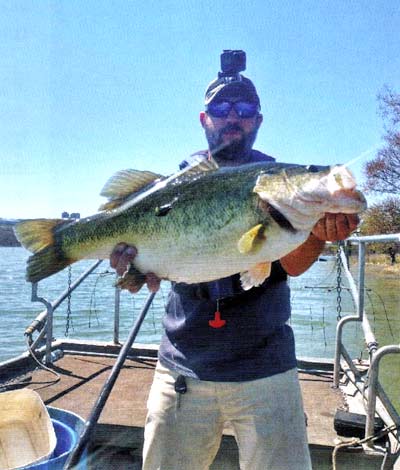
In 2019, the original generation of Largemouth bass turned two years old, and many were between 4 and 5 pounds. Much to everyone's amazement, a 10-pound, 4-ounce female bass rolled in front of the electrofishing boat while Paul Dorsett and crew worked around the perimeter, collecting fish. As seen in the photo, this young bass was incredible—at just 24 months old.
A two-year-old bass in double-digits is unheard of.
The bass numbers were low, as expected in a two-year-old fishery stocked with 15 bass fingerlings per acre. After a conversation, between Paul and Bucky, 17 bass ranging from 3.75-5.20 pounds, as well as this outstanding 10-pound bass, were relocated to 17-acre Horse Pasture Lake. It had also dried up in the drought and was reworked and restocked with forage fish at the same time as South Mill. In spring 2017, black crappie and hybrid striped bass were stocked here, rather than Largemouth bass. Like South Mill, threadfin shad were stocked annually. Additionally, golden shiners were stocked on two occasions, and additional black crappie since it was difficult to determine if crappie had been established.
This 17-acre lake has a maximum depth of 25 feet, averages 6-7 feet, and a 2,200-acre watershed. Although both lakes have similarities, Horse Pasture had been maintaining higher clarity and had a great deal of bushy pondweed. The fishery struggled to establish as well as South Mill early due to low water levels and clear water, exposing the forage base to many cormorants.
When the decision to move the 18 fast-growing bass into Horse Pasture in 2019 was made, the lake was finally catching its stride and teeming with 3-7-inch bluegill, redear sunfish, golden shiners, and some black crappie.
This was another perfect environment for these 18 bass to continue maximiz¬ing their growth potential. In the following spring of 2020, three of the original 18 Largemouth Bass were recaptured during the routine electrofishing study. Although the fish looked great, ranging from 4.95 to 7.11 pounds, none of these three-year-old fish were the legendary fish we hoped to find. During that sampling event, a decent number of intermediate-size bass were collected. These fish were offspring of the 18 large bass. Many were harvested to reduce their population to help ensure the forage base was not overwhelmed. There are two key points here—18 bass larger than 3.75 pounds were stocked, meaning at least one of those fish was a male. Second, great genetics lend excellent genetics. We know the second generation of bass has the same essential genetics as the first stocking's best-of-the-best.
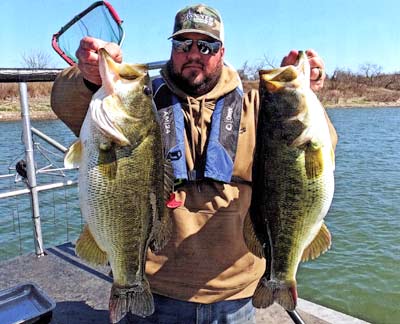
Anxious to study progress, in the fall of 2020, Horse Pasture Lake was electrofished again, this time at night. During that sampling event, intermediate-sized Largemouth bass were harvested to reduce the number of small bass, but unfortunately, none of the original 18 bass were collected. Sampling that fall was discouraging, but often, that is how electrofishing for large bass goes.
Over winter, many large mesquite trees were cut and sunk strategically throughout Horse Pasture Lake in the deeper areas to provide better cover to congregate predator fish and protect forage fish from cormorants throughout the winter months.
In the spring of 2021, Paul and I electrofished Horse Pasture Lake. During the daytime sampling event, we were fortunate to collect four of those original 18 fish. While shocking a narrow, shallow cove, we found the 10-pound bass from two years prior as she hung out in a shallow area less than 12 inches deep. After a bit of excitement and luck, we netted and placed her gently in the freshwater, flowing live well.
The hair on our necks stood up, and our hearts were racing because we knew we were likely looking at a once-in-a-lifetime fish.
She was egged up and heavy but still 2-3 weeks away from spawning. While still docile from the capture, Paul collected length and weight data. Just shy of 48 months old, she was 24 inches and weighed a whopping 14 pounds, 3 ounces. After a few photos, Paul gently released her as she started waking up. We watched her swim away effortlessly and breathed a sigh of relief that she made it back into the lake with no issues and recognized with excitement that she had grown an average of two pounds per year over the last two years.
We had to sit down for a few minutes and regain our composure before continuing the survey. That fish is nothing short of amazing.
It isn't easy to project how long she might live since little data exists on fish that grow so quickly. Hopefully, she can survive to age seven or eight. If so, there is a more than reasonable chance she can exceed the current Texas State record of 18 pounds 2.8 ounces. We have to remember that there are lots and lots of variables. So far, this fish has defied all logical odds.
Who knows for sure what the future holds for this legendary fish and these two fisheries as a whole, but it is nice to know that all 18 of the fish that seeded Horse Pasture's population were high-quality fish and that the lake likely has incredible genetic potential. As a result, the Nail Ranch is set up for incredible fishing over the years, with hopefully their first of many legendary fish.
We hope to be able to see and touch that fish again in a year or two.
David Beasley is a Fisheries Biologist and the Director of Fisheries at SOLitude Lake Management, an environmental firm providing sustainable lake, pond, wetland, and fisheries management services. Learn more about this topic at www.solitudelakemanagement.com/ knowledge
Reprinted with permission from Pond Boss Magazine

